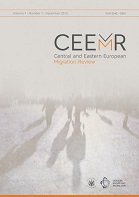Migration and Socio-Demographic Processes in Central and Eastern Europe: Characteristics, Specificity and Internal Differences
Migration and Socio-Demographic Processes in Central and Eastern Europe: Characteristics, Specificity and Internal Differences
Author(s): Aleksandra Grzymała-KazłowskaSubject(s): Social Sciences
Published by: Ośrodek Badań nad Migracjami / Uniwersytet Warszawski
Keywords: migration; emigration; immigration; Central and Eastern Europe
Summary/Abstract: Although Central and Eastern Europe (CEE) is sometimes referred to as a buffer zone (Iglicka 2001) because of its location between the huge Asian continent and Western Europe, it is also an area of intense and diverse migration flows both internal and external. In a broader sense, the region of Central and Eastern Europe may include countries of the Visegrád Group (Czech Republic, Hungary, Poland and Slovakia), the states of the former USSR, as well as southern post-communist states, Bulgaria and Romania, and even the states of the former Yugoslavia and Albania (Okólski 2004; Castles, Miller 2003). This extensive list includes both the countries whose accession to the European Union took place between 2004-2013 (the Visegrád Group countries, the Baltic states, Slovenia, Romania, Bulgaria and Croatia), as well as countries which are not EU member states. The EU enlargements created a considerable difference between the status of the countries which became part of the EU and the other states of the region, and influenced intra- and extra-regional migration processes.
Journal: Central and Eastern European Migration Review
- Issue Year: 2/2013
- Issue No: 1
- Page Range: 5-11
- Page Count: 7
- Language: English

